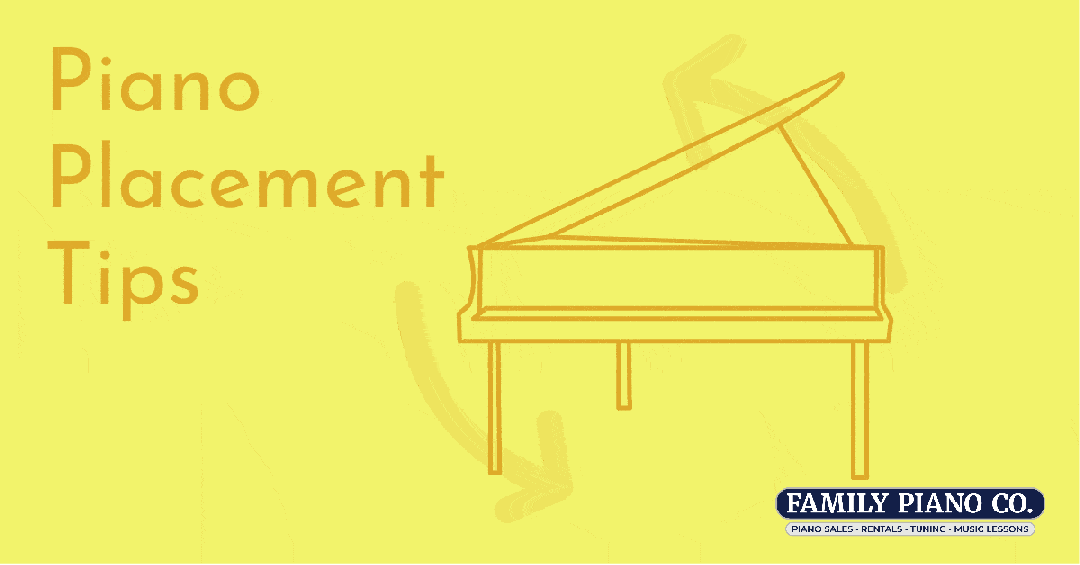A piano is built to last for a lifetime. But whether or not it’s worth keeping by that point largely depends on how well it’s taken care of.
Choosing a proper placement for your piano within your home helps will ensure that your piano plays and sounds at its best for years to come.
And although this can be a complicated topic, we’re going to try to break it all down as simply as possible.
Ensuring the Piano’s Safety
In most cases, the rule of thumb is that “if you’re comfortable, your piano is comfortable too.” However, it will go a long way to ensure with 100% certainty that your piano is placed well.
Constant Temperature
Pianos are best kept in a room that is set at a constant 70-72° F. Any higher or lower than that can upset the tuning, weaken the delicate internal glue, and contribute to long term wood damage.
Temperature fluctuations can be avoided by:
- Keeping your piano away from exterior walls, drafty windows and doors, fireplaces, and climate-control vents.
- Keeping the room protected and well-insulated if your area has temperature extremes.
- Placing an area rug beneath your piano on cold floors. This can also help balance out an overly-bright piano.
Consistent Humidity
A piano prospers in 35-45% humidity, but can handle up to 55%, as long as it’s constant.
Fluctuating humidity causes wood to swell and release, hurting the soundboard, and leading to tuning issues, changes in timbre, silent keys, and a plethora of other avoidable problems.
If you own a digital piano, keeping the humidity level at at least 55% prevents static electricity damage.
Prevent Exposure to the Elements
It’s also critical that your piano is kept away from windows and doors. Exposure to the elements can cause damage to your piano.
- Condensation can be avoided by keeping windows and doors well-insulated; both of which should remain closed when less than 4 feet from a piano. This is a particular threat to digital pianos and keyboards.
- As much as possible, keep the piano lid closed, and invest in a quality cover for your digital piano. Dust, pollen, and smoke can all easily reach a piano’s delicate interior. The effects are then worsened with any condensation which coats the inside with a sticky, bacteria-ridden residue.
- Direct sunlight should never hit a piano, whether it’s digital or acoustic. Indirect sunlight can help prevent mold and yellowing keys in acoustic pianos, but be sure to closely monitor the temperature in a sunny piano room.
And while we’re focusing on the piano’s safety, we do also want to mention the room’s safety! We recommend you place your piano on caster cups to prevent scratches on the floor. A piano’s wheels usually aren’t that great so doing this will keep the instrument in place and prevent significant damage to any wood flooring.
Enhancing the Piano’s Sound
Your piano’s room should improve your piano’s tone.
That said, there is an art and science to sound treating a room that’s hard to explain simply. Many factors are involved, and there are a lot of things that people consider when trying to get “the perfect sound.”
So here are some of the easiest guidelines to follow that’ll still make a difference.
Tips Depending on the Tone
- Clear-sounding bright pianos are balanced in rooms with sound-absorbent surroundings, including carpeting and wall hangings.
- Subtle, mellow piano voices are complemented by wooden floors and other hard surfaces.
- Digital pianos are dependent on the strength and quality of the speakers used. A smaller room works best with built-in speakers, but external speakers can always be added to suit a room.
Best Practices for Room Placement
- Place your piano against an interior wall. This allows the piano’s sound to reflect better, and it’ll sound bigger as a result. We recommend leaving a little room behind uprights and facing the open lid against the wall for grands.
- Avoid placing your piano near windows and in corners. Windows can cause the piano to sound harsh and tinny, and corner placement will cause the bass to build up in unflattering ways.
- Hard-wood floors are highly adaptable to the needs of your piano so we usually recommend placing it on one. Area rugs can be used to customize the sound of the room from there.
- Secure any vibrating surfaces such as loose shelves and even music desks to avoid harsh tones and ringing.
The shape and size of the room you place your piano in will of course make a difference as well. And we do generally recommend you avoid a square room, but in most homes, there are only so many places where a piano will fit.
We will also say: a piano in a square room that’s been sound treated will sound better than a piano in a bigger room that had zero mind paid to acoustics.
So prioritize the room where the piano will be seen and played more often. As long as it’s also safe for the piano, that’s much more important than the acoustics in our opinion.
Read a more in-depth guide on room selection in PianoBuyer’s post on piano placement.
Overall: 5 Things to Remember
There’s a lot to consider when buying a piano. Placement can certainly become an overwhelming part of that, but you shouldn’t let it be.
This is a topic that tends to be overcomplicated. “If you’re comfortable, your piano is comfortable” is a fine rule-of-thumb for the piano’s safety. And for sound, unless you’re recording the instrument, a little will go a long way as you’re starting off.
- Keep the temperature and humidity constant. This will greatly improve your piano’s tuning stability, and it’ll keep all its wood in good shape.
- Avoid placing your piano next to windows and doors. Direct sunlight will damage the piano’s finish and can cause mold. Plus it would mess with that constant temperature and humidity thing too.
- “Good sound treatment” is highly subjective. Start with the basics, and use your ears to find a sound you like. You can invest in thicker curtains, acoustic foam, sound diffusers, bass traps and a whole lot more to play with the characteristics of the room.
- Remember that sound is affected by surfaces. Hard ones bounce sound; soft ones absorb it. Stay mindful of the material of your furniture.
- Become good friends with your technician. Regular visits — yearly at the least — will also help your piano stay in good shape. And you can ask your technician about voicing and other services that’ll help the sound.





0 Comments